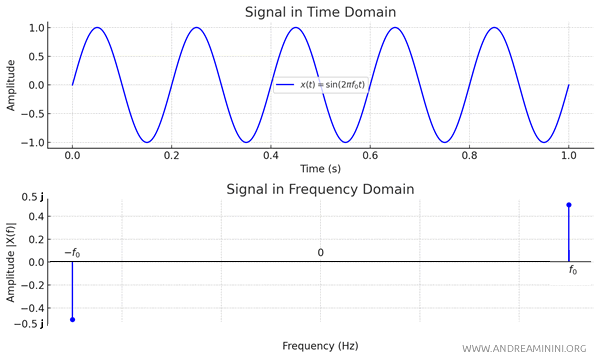Fourier Transform of the Sine Function
The Fourier transform of the trigonometric function of the sine in the time domain
$$ x(t) = \sin(2 \pi f_0 t) $$
is computed by evaluating the Fourier integral
$$ X(f) = \int_{-\infty}^{+\infty} x(t) \cdot e^{-j 2 \pi f t} \, dt $$
However, it’s far simpler to express the sine function using complex exponentials, utilizing Euler's formula:
$$ x(t) = \sin(2 \pi f_0 t) = \frac{e^{j 2 \pi f_0 t} - e^{-j 2 \pi f_0 t}}{2j} $$
Consequently, I can rewrite \( x(t) = \sin(2 \pi f_0 t) \) as:
$$ x(t) = \frac{1}{2j} e^{j 2 \pi f_0 t} - \frac{1}{2j} e^{-j 2 \pi f_0 t} $$
Next, I will compute the Fourier transform of each term separately:
$$ X(f) = F \left[ \frac{1}{2j} e^{j 2 \pi f_0 t} - \frac{1}{2j} e^{-j 2 \pi f_0 t} \right] $$
Thanks to the linearity of the Fourier transform, I can express this as
$$ X(f) = \frac{1}{2j} \cdot F \left[ e^{j 2 \pi f_0 t} \right] - \frac{1}{2j} \cdot F \left[ e^{-j 2 \pi f_0 t} \right] $$
From known Fourier transforms, I can assert that:
- The transform of \( e^{j 2 \pi f_0 t} \) corresponds to an impulse at \( f = f_0 \),
- The transform of \( e^{-j 2 \pi f_0 t} \) corresponds to an impulse at \( f = -f_0 \).
Thus, substituting these results yields the Fourier transform of \( x(t) = \sin(2 \pi f_0 t) \) as:
$$ X(f) = \frac{1}{2j} \delta(f - f_0) - \frac{1}{2j} \delta(f + f_0) $$
In conclusion, the Fourier transform of the sine function is represented as the difference of two impulses located at frequencies \( \pm f_0 \), with an imaginary factor of \( \frac{1}{2j} \) that reflects its sinusoidal nature.

This expression illustrates how the energy of the sine function concentrates at frequencies \( \pm f_0 \) in the frequency domain, but with a different phase compared to the cosine function.
And so forth.
